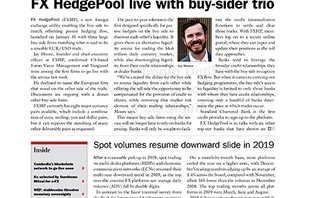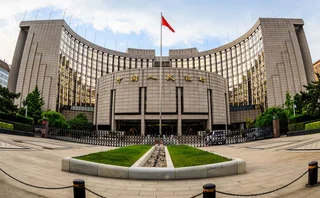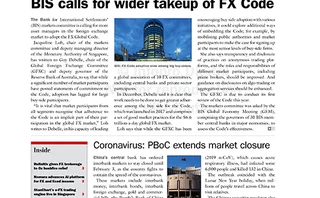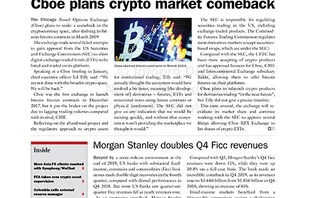
Buy-side call for algorithmic execution in foreign exchange

Foreign exchange market participants are predicting a period of rapid change in execution models over the next three years, as institutional use of new algorithmic execution strategies increases.
While a boom in algorithmic-driven execution strategies was predicted four years ago, the 2008 post-Lehman Brothers crash intervened, and for many pension funds, asset managers and insurance companies, fine-tuning their FX execution lagged as focus shifted to managing fixed income and equities portfolios in a highly volatile environment.
By the end of 2010, overall FX algorithmic adoption reached a mere 7%, according to research from Boston-based consultancy Aite Group. But, says Aite, this figure is expected to rise to more than 25% by the end of 2014, driven by the need for greater transparency and operational efficiencies.
High volatility and poor returns in many asset classes has encouraged large institutional investors to scrutinise their costs more than ever, with an unwillingness to give up part of overall returns on poor FX execution. And the gains or losses to be made via execution strategies are even bigger in less liquid emerging market currencies.
Change is not just being driven by cost concerns, but also by regulatory initiatives such as the Markets in Financial Instruments Directive II, which require market participants to clearly show they are getting best execution across all aspects of a securities trade.
James Dalton, director in the algorithmic execution team, CitiFX Intelligent Orders in London, says it is still early days in FX for the algorithmic business, and predicts growth in this area to be exponential over the next 12 to 18 months. The US bank has been one of the heaviest investors in algo-driven FX products, having begun offering complex algorithmic-driven FX trading strategies since 2007. These include trading, risk management and reporting tools for clients ranging from more passive investors such as pension funds, to high-frequency trading shops.
"A buy-side customer may have a multibank execution facility that works well for 60% of its order flow, but may be using it for 100% of order flow. But institutional investors are now getting a better idea of how different types of flows require different execution solutions," he says.
Dalton notes that the 4.00pm London benchmark fixing calculated by data vendor WM, has been an increasingly heavily used execution tool for a lot of passive equity and fixed-income portfolios. The fixing is based on rates provided by electronic FX brokers, Thomson Reuters and Icap-owned EBS, 30 seconds either side of 4:00pm. But more institutions now want to get better execution via algorithms and not just take an average, he says.
"For a pension fund, a first step may be a pricing agreement around benchmark fixings, but they are now looking at taking it to the next level, which means executing at more opportunistic times ahead of the fixing with the help of algorithimic platforms," says Dalton.
An example is the bank's passive execution strategy called Silent Partner, which takes advantage of interbank and CitiFX liquidity. Having calculated the optimal execution horizon, the model consumes liquidity at a rate consistent with the market profile of the currency pair, using a historic granular liquidity map that looks at factors such as time of day, day of week or seasonality. It also dynamically takes advantage of surplus liquidity as it appears.
Another model, Liquid Slice, is a time-weighted price strategy, where the client enters the notional amount and duration of the trade. Liquid Slice then breaks up the order into appropriate clips and increments. The strategy is indicative of how advanced algo techniques developed for equities trading are transferring very quickly into FX.
A pioneer of algo execution strategies in the equities market, Credit Suisse leveraged its expertise to roll out in FX as part of its Advanced Execution Services (AES) platform in 2006. The platform uses a pure agency model that charges on commission as opposed to margin on clients' trades.
Jonathan Wykes, global head of AES FX sales at Credit Suisse in London, says there has been a move away from a simple interpretation of best execution compliance, where a pension fund would traditionally line up five banks and take the best price. "This approach fulfils their compliance obligations, but at the same time signals to the market exactly what they are doing, and allows banks to show what could be described as their worst best price," he says.
"Instead, real money and pension fund institutional clients are taking a wider view of best practice, and increasingly utilising algo strategies, which can be customised to the nth degree, for example splitting up a large FX trade according to set participation levels. The buy side has become very sophisticated, and it wants to be in control of its strategy, and be able to continuously fine-tune it."
The Swiss bank has been providing post-trade reporting for more than five years, but over the past 18 months, Wykes says, it has stepped it up to a new level in an attempt to make the OTC market more transparent for clients. Again, converting technology from equities into FX, the bank recently launched Instant Colour for FX. "It gives a detailed breakdown of performance, looking at the overall execution profile, the duration of the trade, and spread capture, for example how much of the trade was done inside the bid/offer spread," he says. "We provide extremely granular data for our clients to analyse."
Algorithmic strategies help trade along with the flows, and avoid a situation where a large order moves the market. The client agrees to a participation cap that might for example be set at 30% of flows at any given point in time.
Such concepts have been common on equities execution venues for some years, but in the FX market there is a shortage of information about volumes being traded, so there is a need for algorithms that estimate the volume going through the market.
Dealers offering algorithmic execution tools that only trade on the banks' own liquidity argue that in so doing, clients avoid the risk of trading on a liquity mirage, where the same liquidity is offered across multiple venues. This in part reflects the re-publishing of prices made by market-making banks, by high-frequency traders.
Barclays Capital was one of the pioneers of algorithmic execution in FX with the PowerFill suite of tools it began rolling out in 2006. The orders are only executed against the bank's own liquidity.
Marek Robertson, head of e-distribution for EMEA at Barclays Capital in London, notes that in the decade up to 2010, the FX market was characterised by ever-increasing liquidity, with tightening spreads as extra decimal places were introduced, while electronic trading brought in new participants. However, assumptions about liquidity have been tested by various market shocks since.
"When liquidity becomes challenged, clients want the ability to execute at price rather than managing trades via algo tools, and at those times there are typically fewer electronic market-makers out there," says Robertson. "The market is bringing new challenges, and it is important for us to be there in all market conditions, delivering consistency and reliability to our clients."
Similarly, Deutsche Bank also executes algorithmic orders anonymously on behalf of clients into its own liquidity pool. It began rolling out algo-based strategies in FX through its AutobahnFX Algo platform in 2009. "Deutsche Bank has one of the largest global pools of FX liquidity, and we are also connected to a wide range of execution venues," says Cameron Mouat, head of algorithmic execution for FX at Deutsche Bank in London. "This enables us to find real liquidity, rather than execute against high-frequency market-makers."
Citi also has its Ripple model, which was exclusively designed to execute into liquidity drawn from the flows Citi sees directly from clients via its electronic price distribution network.
One of the risks highlighted by Aite to broader adoption is suspicion over the bank's intentions. "There is also the client's natural suspicion over the bank's ultimate intentions behind offering execution algos to clients. In this largely principal-based trading environment, a certain level of convincing is needed to push clients towards leveraging bank-provided algos, which could potentially tighten the spreads even more, thereby hurting the bank's bottom line on a per-transaction basis," says Sang Lee, consultant at Aite Group in Boston.
To that end, and like Credit Suisse, Deutsche Bank also offers many of its institutional clients access to its transaction cost analysis (TCA) product to provide greater transparency on their FX trades. Mouat says the bank is seeing more institutional clients using algorithms to minimise the potential cost of market impact. The bank has a model called Stealth, an opportunistic algorithm that uses advanced quantitative models to analyse market conditions in real time to reduce execution costs.
One high-profile new entrant currently developing an algorithmic platform is Ogg Trading, run by David Ogg, who launched HotSpot FX in 2000 and sold it to Knight Capital in 2006. Ogg Trading has entered a strategic partnership with existing trading system provider Pragma Securities, and will launch before the end of the year. "The disparate pools of liquidity out there are fragmented, and have different styles of trading," says Ogg. "To take one example, a platform may have a last-look provision, while another will have no last look. It gets harder to intelligently aggregate and wrap trades."
Ogg says the single-bank platforms have become more sophisticated and have added new algorithms, with some more advanced than others. "But there is a lot of room for improvement in best execution, and there is a lot of new technology still to come," he says, declining to comment on his own strategies.
The FX market is in for a busy period of development over the next 12 months, as buy-side institutions review their FX relationships and look for new cost-saving strategies. Similarly, a draft of the European Market Infrastructure Regulation directive was voted on in the European Parliament in July, and is on course to be implemented in 2012, while the Markets in Financial Instruments Directive (Mifid) is being reviewed, which will result in Mifid II, probably in 2013. Spot FX is not impacted, though some FX derivatives are, but most large buy-side institutions have already embraced the idea of best execution for the FX component of their equities or fixed-income trades.
BarCap's Robertson says that while the bank has been offering clients algo tools to slice up orders and minimise market impact since 2006, "uptake has certainly increased in the past couple of years, thanks to the influence of equities, as well as regulatory initiatives such as Mifid."
And with total electronic FX volume expected to account for 70% of all FX trading by the end of 2012 - up from 68% at the end of 2010 - coupled with this increased use of algo strategies by institutions, there is currently plenty of business to go round for aggregators, multi-bank platforms and single-bank platforms, as they develop expensive fourth-generation FX tools.
Institutional FX trading platform, FXall, recorded a 37% increase in average daily volume for Q2, 2011 compared with the same quarter last year. Volume in July was up by 49% compared with July 2010, and $140 billion was traded on FXall in a single day on July 27, which was a new record for the company.
This trend towards ever-rising volumes of global FX trading is underpinning the heavy investment needed to be made by firms to keep up with technological change, and the growing use of existing algo platforms.
Only users who have a paid subscription or are part of a corporate subscription are able to print or copy content.
To access these options, along with all other subscription benefits, please contact info@fx-markets.com or view our subscription options here: https://subscriptions.fx-markets.com
You are currently unable to print this content. Please contact info@fx-markets.com to find out more.
You are currently unable to copy this content. Please contact info@fx-markets.com to find out more.
Copyright Infopro Digital Limited. All rights reserved.
As outlined in our terms and conditions, https://www.infopro-digital.com/terms-and-conditions/subscriptions/ (point 2.4), printing is limited to a single copy.
If you would like to purchase additional rights please email info@fx-markets.com
Copyright Infopro Digital Limited. All rights reserved.
You may share this content using our article tools. As outlined in our terms and conditions, https://www.infopro-digital.com/terms-and-conditions/subscriptions/ (clause 2.4), an Authorised User may only make one copy of the materials for their own personal use. You must also comply with the restrictions in clause 2.5.
If you would like to purchase additional rights please email info@fx-markets.com
More on Foreign Exchange
Average reported daily UK FX turnover hits record high
Daily turnover of $2,881bn in October 2019, up 2% from previous high of $2,821bn in April
PBoC injects 1.2 trillion yuan as markets plunge
Chinese central bank eases to support economy as coronavirus spreads; Q1 GDP growth could drop to 4%
Spot volumes on platforms resumed downward trend in 2019
But an uptick was seen in FX swaps and forwards submitted for settlement
PBoC extends market closure as coronavirus spreads rapidly
Chinese central bank extends interbank markets closure and vows to maintain ample liquidity







